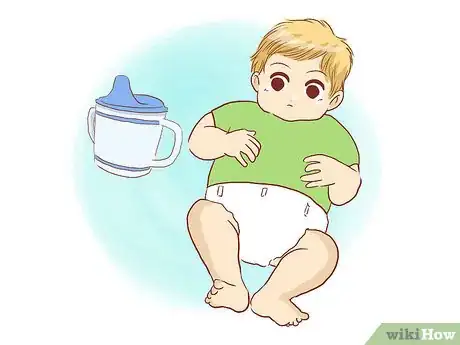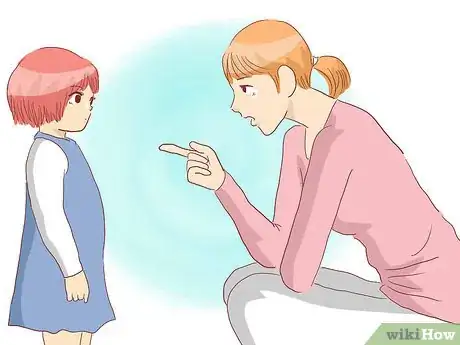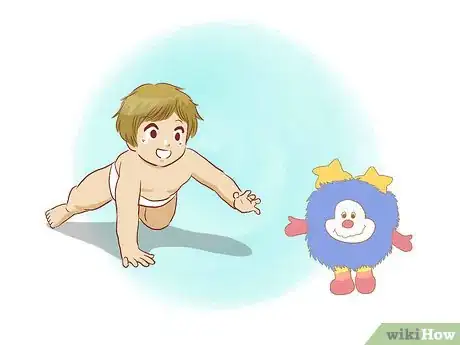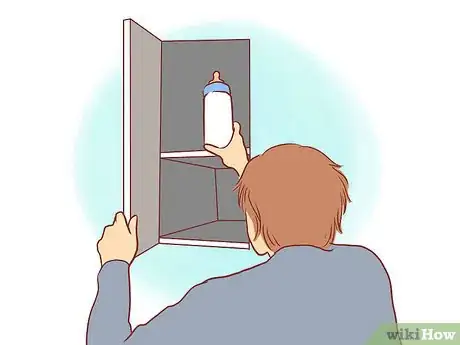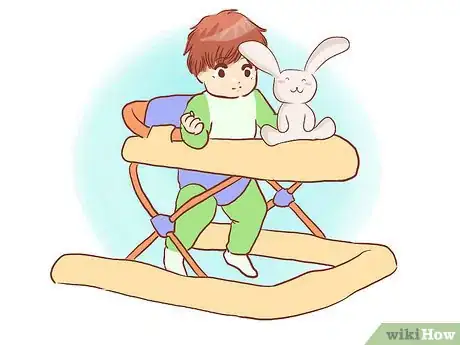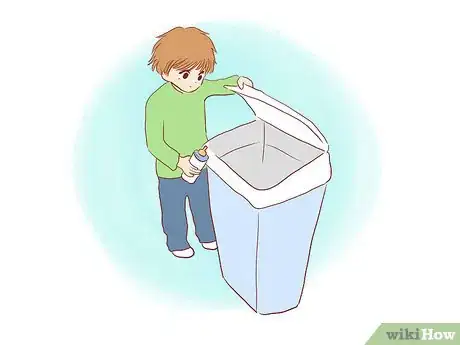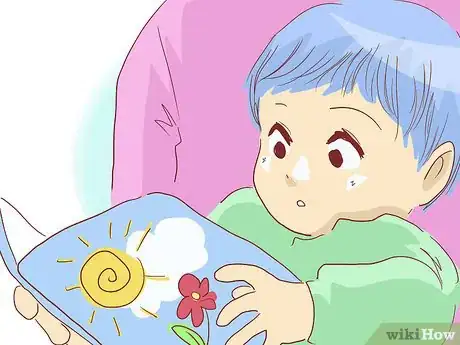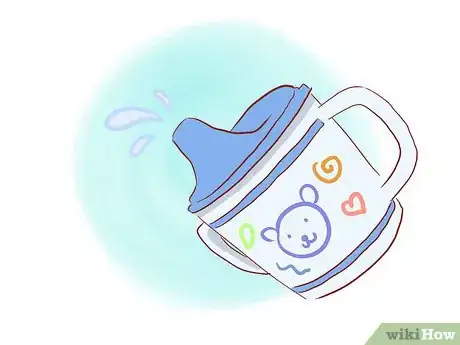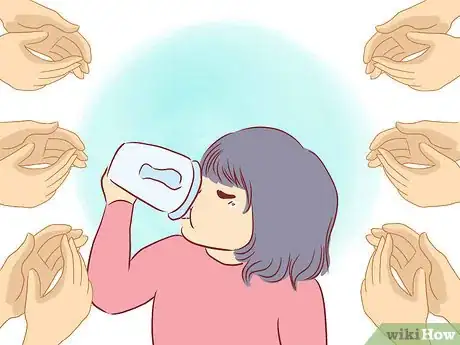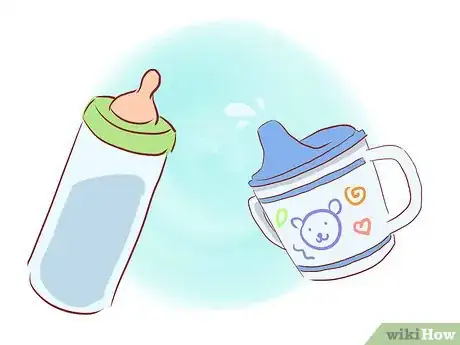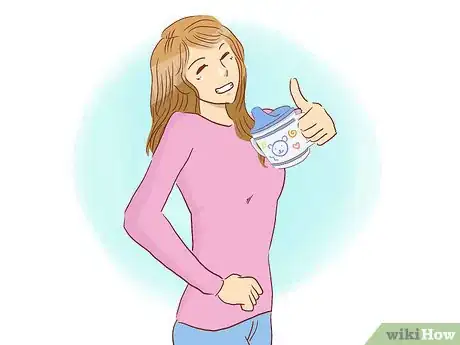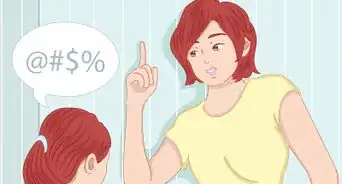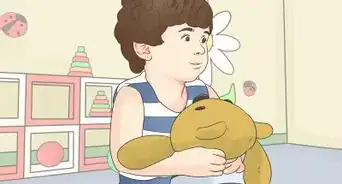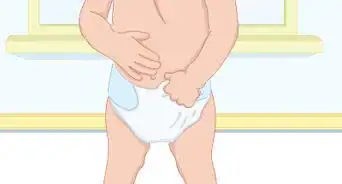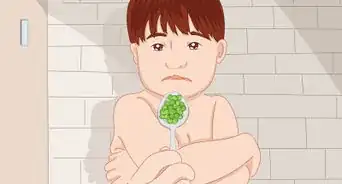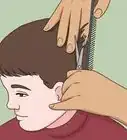wikiHow is a “wiki,” similar to Wikipedia, which means that many of our articles are co-written by multiple authors. To create this article, 9 people, some anonymous, worked to edit and improve it over time.
This article has been viewed 57,710 times.
Learn more...
It is not uncommon for toddlers to become attached to their bottles. Bottles can often become a source of comfort that turns into a habit. However, it is important to transition your toddler to using a cup, rather than a bottle. In order to do this, you will have to determine the right time to do this before you begin.
Steps
Choosing the Right Time to Stop Bottle Feeding Your Child
-
1Consider introducing your child to cups when she turns six months old. While your child might not be able to completely drink from a cup independently, beginning at this age will help her to become familiar with the cup.[1]
- Consider giving your baby a sippy cup to play with in order to get them familiar with the object.
-
2Switch your child’s formula when he or she turns one. At around one year of age, your child can begin drinking cow’s milk rather than formula. At the same time, you can introduce your child to drinking out of the cup (rather than just playing with it). Giving your child a new cup and a new drink at the same time may help her to make the transition.
- If you notice any rash, redness, difficulty breathing, vomiting, or diarrhea when you give your child cow’s milk, consult your doctor right away. Your child may have an allergy to milk.
Advertisement -
3Pick a time to stop bottle feeding your child. If your child is stressed for some reason, such as that you just moved to a new house, you may want to delay taking away the bottles entirely, as this could cause further stress. Instead, wait for a time when your baby is in a good mood and generally stress-free.[2]
- Do not switch your baby entirely to cups if she is sick or just beginning preschool.
-
4Tell your toddler about your plans. When you include your child in your plans, they will most likely be more receptive to them. Talk to your child about how they will have to start using a cup soon because he or she is a ‘big girl ’ or 'big boy' now.[3]
- Speak positively about the cup and say that the bottle is only for babies.
- If you have an older child, ask him or her to talk to your toddler about how big kids use cups. Your younger child may be more inclined to emulate her older sibling.
Weaning Your Child Off the Bottle
-
1Reduce the frequency that you give your child bottles. During the first week of transition, take away one bottle-fed meal. If possible, take away the morning bottle feed and replace the bottle with milk from a cup or a different kind of food. Giving up the morning bottle first is best that way if your child comes asking for a bottle for in the afternoon or at night you reassure them one is coming later in the day.
-
1
- During the next week, take away an afternoon bottle.
- The last bottle to go should be the dinner or bedtime bottle. Wait to do this until your child has accepted not receiving bottles in the morning or afternoon.
-
2Figure out what your toddler really wants when she demands her bottle. If your toddler insists on the bottle, do not give up. Find out what your toddler really wants; often, your toddler will ask for the bottle because she wants comfort, not because she actually wants to drink her formula. If this is the case, soothe and comfort her yourself.[5]
- If your child is hungry or thirsty, offer her something to eat or drink without the bottle.
- If your child refuses both comfort or other food or drink, give her the bottle. Do not force her; weaning your child off the bottle will be a gradual process. Instead, talk to her some more about why you want her to drink from a cup.
-
3Remove the bottle from view. When you decide to start transitioning your child off of using bottles, make sure to hide them completely (or throw them away) so that your child does not get reminded of the bottle and begin demanding it again.
-
4Do not let your child carry around a bottle. This is important to enforce as soon as you begin feeding your child with a bottle; the bottle should be used only for feeding during meals. If your child is allowed to carry the bottle around, it may begin to represent something other than feeding.
- If your child already carries a bottle around, offer her some other comforting object, like a toy or blanket.
-
5Help your child to throw a bottle away. You can make a big deal about this process. Let your child throw the bottle into the trash and say goodbye to it. Doing this will help your child to know that there are no more bottles.
- If it is around a holiday, such as Christmas, you can help your child to put all of the bottles into a box to leave for Santa Claus. Tell your child that Santa will replace the bottles with a gift.
- Alternatively, you could have your child leave the bottles for the ‘Bottle Fairy’. Have the fairy leave a comforting gift for your child.
-
6Change your child’s routine. If the bottle was part of your child’s bedtime routine, replace the bottle with something interesting, like reading a picture book, or singing a song. You can also offer your child milk in a cup when she would normally get her bottle.
Teaching Your Child to Use a Cup
-
1Choose the right cup. Look for a cup that has handles so that your child has an easier time holding it. The cup should be made of a lightweight material like plastic. The cup should have a lid so that spills are avoided (for the most part).
- Look for a cup that is made of bright colors, or has a picture of your child’s favorite movie or book character on it. When the cup has something on it that your child likes, your child will be more inclined to use it.
-
2Make sure the liquid will be easy to drink out of the cup. Try to drink from the cup before you give it to your child. If your child tries to drink out of it, only to find that the liquid doesn’t flow easily out of the cup, then she may become frustrated and ask for her bottle again.[6]
-
3Be positive about the change. Introduce the cup with enthusiasm. Present it as a cool tool that big kids use to drink. Praise your child whenever she uses the cup, and tell her how impressed you are.
- Consider rewarding your child when she uses the cup. Give her hugs, take her to the park, or reward her with a healthy snack. Do this only at the beginning when you are trying to help your child accept the cup as a habit. Over time, replace the reward with praise only.
-
4Use your child’s drinks to your advantage. When your child is still drinking out of both a bottle and a cup, begin diluting the milk in the bottle so that the milk in the cup tastes better. Your child will most likely begin asking for the cup more often than the bottle.[7]
- Give your child her favorite drinks in a cup, while only sticking to water or drinks she doesn’t like as much from the bottle.
-
5Be a good role model by drinking from your own cup. Children often copy what they see their parents doing. Pour milk into your own cup and show your child how you drink it. Offer a cup of milk to your child at the same time. Show your child how to lift the cup.[8]
- Help your child by showing your child how to grasp the cup and lift it to her mouth.
Community Q&A
-
QuestionMy daughter is 5 and still drinks milk in a bottle. She doesn't want to drink milk from a cup, and she throws tantrums if I try to make her. What do I do?
 Community AnswerYour first option is to simply throw away all the bottles. Then she will just have to put up with the cup if she wants milk. Your second option is to add something unpleasant tasting to the milk in the bottle, then give her a cup and explain that milk always tastes better in a cup. You will have to put up with some tantrums either way, but if you keep letting her have her way, things will never change.
Community AnswerYour first option is to simply throw away all the bottles. Then she will just have to put up with the cup if she wants milk. Your second option is to add something unpleasant tasting to the milk in the bottle, then give her a cup and explain that milk always tastes better in a cup. You will have to put up with some tantrums either way, but if you keep letting her have her way, things will never change. -
QuestionMy child is 10 and still drinks from the bottle. When she drinks from the cup she says that the milk smells. I even tried using a straw but it didn't work, any help?
 Community AnswerIf the milk smells from the cup, but not from the bottle, consider having her watch you pour it from the bottle into the cup. Some other options are allowing her to choose 2 of her very own cups from perhaps the dollar store or Walmart, so that they will take ownership of the cup situation. Another option would be to try a different brand of milk.
Community AnswerIf the milk smells from the cup, but not from the bottle, consider having her watch you pour it from the bottle into the cup. Some other options are allowing her to choose 2 of her very own cups from perhaps the dollar store or Walmart, so that they will take ownership of the cup situation. Another option would be to try a different brand of milk. -
QuestionMy daughter is 2 years 11 months, but she always wants to drink water in a bottle. She even wakes and asks at night. What can I do?
 Community AnswerStart by denying some of the requests and offering a sippycup instead. Then when she is not using the bottles as much, dispose of them. Remember to be patient and take small steps at a time.
Community AnswerStart by denying some of the requests and offering a sippycup instead. Then when she is not using the bottles as much, dispose of them. Remember to be patient and take small steps at a time.
References
- ↑ http://kidshealth.org/parent/pregnancy_newborn/feeding/no_bottles.html
- ↑ http://www.webmd.com/parenting/baby/features/bottle-to-cup?page=2
- ↑ http://www.parenting.com/article/on-call-getting-off-the-bottle
- ↑ http://kidshealth.org/parent/pregnancy_newborn/feeding/no_bottles.html
- ↑ http://kidshealth.org/parent/pregnancy_newborn/feeding/no_bottles.html
- ↑ http://www.easybabylife.com/baby-wants-feeding-bottle-at-night.html
- ↑ http://www.webmd.com/parenting/baby/features/bottle-to-cup?page=2
- ↑ http://www.easybabylife.com/baby-wants-feeding-bottle-at-night.html
About This Article
If you want to stop bottle feeding your toddler, it’s best gradually introduce them to using cups so they get comfortable with it. To start, replace their bottle with a sippy cup just 1 meal per day. After about a week, replace their bottle with a cup at another meal. Once they’re used to this, you can take away their last bottle. If your child makes a fuss, comfort them and try to explain that the cup is a positive thing that they get to use because they’re getting bigger. During the transition, it’s best to keep bottles hidden away when they’re not being used so your toddler isn’t reminded of the old comfort. To learn how to choose the right sippy cup for your toddler, read on!
